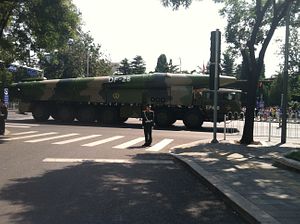The Chinese military has inducted a new intermediate-range ballistic missile (IRBM) capable of hitting U.S. military installations on Guam, the largest and southernmost of the Mariana Islands, a new report by the U.S.-China Economic and Security Review Commission reveals.
The Dongfeng-26C (DF-26C), a conventionally armed IRBM, has in all likelihood been deployed as an operational weapon the report claims, although it is unclear in what quantities and into what brigades of the People’s Liberation Army (PLA).
“Foremost among China’s military assets capable of reaching Guam, the DF-26 IRBM represents the culmination of decades of advancements to China’s conventional ballistic missile forces,” according to the report.
Sixteen DF-26 launchers were publicly displayed during the September 2015 parade in Beijing, which commemorated the 70th anniversary of Japan’s surrender in China. Overall, the PLA fields around 1,200 ballistic missiles of all ranges armed with both conventional and nuclear warheads.
The DF-26 IRBM purportedly features a new “modular design” and can be armed with “two types of nuclear warhead and several types of conventional warhead which use different destructive mechanisms to attack specific targets,” according to two experts of the PLA Academy of Military Sciences, quoted in the report.
The IRBM allegedly also has an anti-ship variant. However, the report cautions:
The PLA has not conducted a successful publicly-reported test of either missile against a moving target at sea,55 and the additional range of the DF-26 likely complicates the targeting challenge China already faces with the DF-21D. China’s ability to employ DF-26 ASBMs in precision strikes against U.S. carriers near Guam will thus remain uncertain until the PLA demonstrates this capability (…).
The report also notes that the missile “likely has serious accuracy limitations” and in its conclusion the paper states that the risk of a successful strike on Guam is relatively low for now:
Currently, accuracy limitations and platform vulnerabilities render this risk relatively low, but China’s commitment to continuing to modernize its strike capabilities indicates the risk will likely grow going forward.
The DF-26 has a purported range of 3,000 -4,000 kilometers (1,800-2,500 miles). As I reported previously (See: “Revealed: China for the First Time Publicly Displays Guam Killer Missile”):
China accidentally revealed the existence of the DF-26C in 2012 with reports about the existence of the missile circulating already since at least 2007. It allegedly can be fitted unto a road-mobile chassis – called transporter-erector-launcher (TEL) – and uses solid fuel. Based on the TEL, it appears that the DF-26C is produced by the China Aerospace Science and Technology Corporation (CASC).
The report also discusses other Chinese weapons systems that theoretically could successfully strike Guam and U.S. warships including land-attack cruise missiles, air and sea-launched anti-ship cruise missiles.
“To evaluate China’s ability to strike Guam going forward, the areas that should be monitored most closely are increased deployments of DF-26 missiles and qualitative improvements to China’s precision strike capabilities, bomber fleet, in-air refueling capability, and submarine quieting technology,” the report summarizes.






























